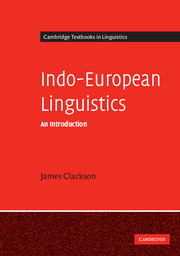Book contents
- Frontmatter
- Contents
- List of figures
- List of tables
- Preface
- Transliteration conventions
- 1 The Indo-European language family
- 2 Phonology
- 3 Morphophonology
- 4 Nominal morphology
- 5 Verbal morphology
- 6 Syntax
- 7 Lexicon and lexical semantics
- Glossary
- References
- Word index
- Language index
- Person index
- Subject index
4 - Nominal morphology
Published online by Cambridge University Press: 05 June 2012
- Frontmatter
- Contents
- List of figures
- List of tables
- Preface
- Transliteration conventions
- 1 The Indo-European language family
- 2 Phonology
- 3 Morphophonology
- 4 Nominal morphology
- 5 Verbal morphology
- 6 Syntax
- 7 Lexicon and lexical semantics
- Glossary
- References
- Word index
- Language index
- Person index
- Subject index
Summary
Introduction
Many handbooks on PIE give handy overviews of the nominal declensions of the parent language. The reader is presented with neat tables, with eight nominal cases running down the side, three numbers (singular, dual and plural) and an array of nominal declensions, partly corresponding to the three grammatical genders of masculine, feminine and neuter. There may be discussion about which of the competing morphs was the original exponent of a particular category, such as the genitive singular of the masculine and neuter o-stem, but there is in general little explanation of how these categories are the ones which must be reconstructed, and even less discussion of what these categories actually represent.
The primacy of Sanskrit in the early days of research into PIE has had lasting effects on the reconstruction of the nominal system. The reconstructed categories of the PIE noun are exactly the same as those of the Sanskrit noun. Sanskrit has eight cases: nominative, vocative, accusative, genitive, dative, ablative, locative and instrumental; three numbers: singular, dual and plural; and three genders: masculine, feminine and neuter. The only languages to have a wider array of nominal cases are some Baltic variants and Tocharian, but the additional case markers are easily discernible as postpositions or adverbial elements added to more basic case forms, and it is clear that these cases have arisen secondarily, probably through contact with languages with well-developed systems for expressing local cases.
- Type
- Chapter
- Information
- Indo-European LinguisticsAn Introduction, pp. 90 - 113Publisher: Cambridge University PressPrint publication year: 2007



